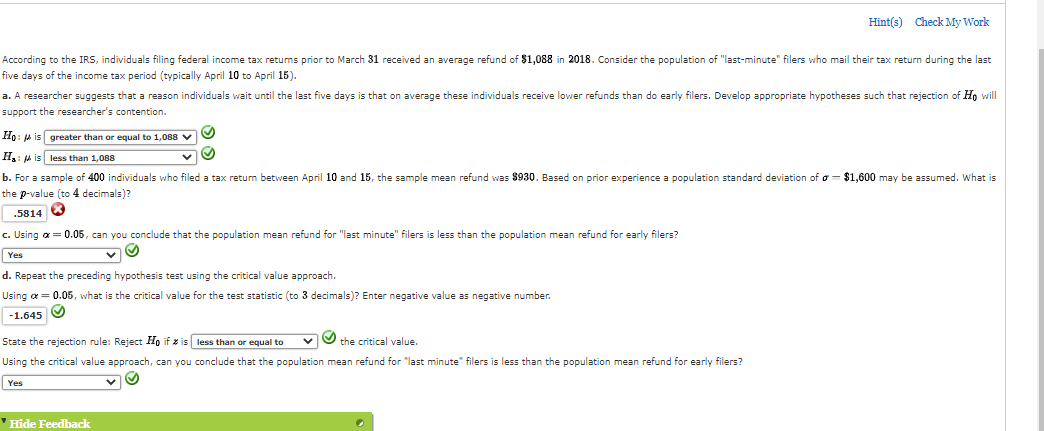According to the IRS, individuals filing federal income tax returns prior to March 31 received an average refund of $1,088 in 2018. Consider the population of "last-minute" filers who mail their tax return during the last five days of the income tax period (typically April 10 to April 15). a. A researcher suggests that a reason individuals wait until the last five days is that on average these individuals receive lower refunds than do early filers. Develop appropriate hypotheses such that rejection of Ho will support the researcher's contention. Ho: is greater than or equal to 1,088 ✔ S S H₁: is less than 1,088 b. For a sample of 400 individuals who filed a tax return between April 10 and 15, the sample mean refund was $930. Based on prior experience a population standard deviation of a $1,600 may be assumed. What is the p-value (to 4 decimals)? 5814 c. Using a 0.05, can you conclude that the population mean refund for "last minute" filers is less than the population mean refund for early filers? Yes d. Repeat the preceding hypothesis test using the critical value approach. Using a 0.05, what is the critical value for the test statistic (to 3 decimals)? Enter negative value as negative number. -1.645 State the rejection rule: Reject Ho if z is less than or equal to V the critical value. Using the critical value approach, can you conclude that the population mean refund for "last minute filers is less than the population mean refund for early filers? Yes
According to the IRS, individuals filing federal income tax returns prior to March 31 received an average refund of $1,088 in 2018. Consider the population of "last-minute" filers who mail their tax return during the last five days of the income tax period (typically April 10 to April 15). a. A researcher suggests that a reason individuals wait until the last five days is that on average these individuals receive lower refunds than do early filers. Develop appropriate hypotheses such that rejection of Ho will support the researcher's contention. Ho: is greater than or equal to 1,088 ✔ S S H₁: is less than 1,088 b. For a sample of 400 individuals who filed a tax return between April 10 and 15, the sample mean refund was $930. Based on prior experience a population standard deviation of a $1,600 may be assumed. What is the p-value (to 4 decimals)? 5814 c. Using a 0.05, can you conclude that the population mean refund for "last minute" filers is less than the population mean refund for early filers? Yes d. Repeat the preceding hypothesis test using the critical value approach. Using a 0.05, what is the critical value for the test statistic (to 3 decimals)? Enter negative value as negative number. -1.645 State the rejection rule: Reject Ho if z is less than or equal to V the critical value. Using the critical value approach, can you conclude that the population mean refund for "last minute filers is less than the population mean refund for early filers? Yes
Functions and Change: A Modeling Approach to College Algebra (MindTap Course List)
6th Edition
ISBN:9781337111348
Author:Bruce Crauder, Benny Evans, Alan Noell
Publisher:Bruce Crauder, Benny Evans, Alan Noell
Chapter3: Straight Lines And Linear Functions
Section3.3: Modeling Data With Linear Functions
Problem 22E
Related questions
Question

Transcribed Image Text:Hint(s) Check My Work
According to the IRS, individuals filing federal income tax returns prior to March 31 received an average refund of $1,088 in 2018. Consider the population of "last-minute" filers who mail their tax return during the last
five days of the income tax period (typically April 10 to April 15).
a. A researcher suggests that a reason individuals wait until the last five days is that on average these individuals receive lower refunds than do early filers. Develop appropriate hypotheses such that rejection of Ho will
support the researcher's contention.
Ho: is greater than or equal to 1,088 ✔
H₂: A is
less than 1,088
b. For a sample of 400 individuals who filed a tax return between April 10 and 15, the sample mean refund was $930. Based on prior experience a population standard deviation of a $1,600 may be assumed. What is
the p-value (to 4 decimals)?
5814
c. Using a = 0.05, can you conclude that the population mean refund for "last minute" filers is less than the population mean refund for early filers?
Yes
d. Repeat the preceding hypothesis test using the critical value approach.
Using a = 0.05, what is the critical value for the test statistic (to 3 decimals)? Enter negative value as negative number.
-1.645✔✔
State the rejection rule: Reject Ho if z is less than or equal to V
the critical value.
Using the critical value approach, can you conclude that the population mean refund for "last minute" filers is less than the population mean refund for early filers?
✔
Yes
'Hide Feedback
Expert Solution
This question has been solved!
Explore an expertly crafted, step-by-step solution for a thorough understanding of key concepts.
This is a popular solution!
Trending now
This is a popular solution!
Step by step
Solved in 4 steps

Recommended textbooks for you

Functions and Change: A Modeling Approach to Coll…
Algebra
ISBN:
9781337111348
Author:
Bruce Crauder, Benny Evans, Alan Noell
Publisher:
Cengage Learning

Functions and Change: A Modeling Approach to Coll…
Algebra
ISBN:
9781337111348
Author:
Bruce Crauder, Benny Evans, Alan Noell
Publisher:
Cengage Learning